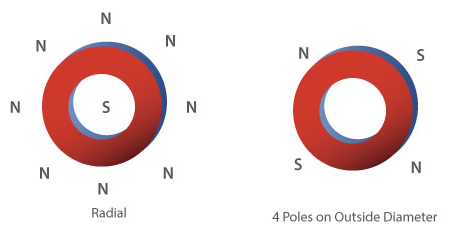Options for Directionality of Magnetization
By Shalea Hardison
In many applications, the direction of a magnet’s pole might not matter – just as long the magnet attracts where needed. However, in other instances, the directionality of the magnet is an integral aspect of the intended application.
Understanding the conventional and specialized magnetization directionality options available helps ensures successful applications.
Polarity Based Magnet Type
Typically the direction of magnetization begins with the two general types of magnets; anisotropic and isotropic.
The majority of magnets are anisotropic meaning they have a preferred direction of magnetization. Anisotropic magnets want to be magnetized in this preferred direction. During the magnetization process, a magnetic field is applied in the direction of magnetization to orient the material and increase the magnet’s performance potential. For this reason, anisotropic magnets may also be referred to as oriented material. Examples of anisotropic magnets include cast alnico and high energy flexible magnetic sheeting .
On the other hand, isotropic magnets have equal magnetic properties in all directions. So it’s possible to magnetize these magnets in any direction. Isotropic magnets, also referred to as non-oriented magnets, are pressed, or cast, with no particular polarity and are magnetized later in the manufacturing process. While this process accommodates a broader range of magnetization options, the resulting magnet never reaches its maximum potential. One example of an isotropic magnet is bonded neodymium.
Once magnetized, a magnet’s directionality cannot be changed. Likewise, once made, isotropic magnets cannot have their preferred direction changed.
Conventional Magnetization Directionality
Most often, ceramic, alnico, neodymium and samarium cobalt magnets are magnetized in conventional patterns. Commonly stocked in our warehouse, and found industry-wide, the following patterns are conventional:
Axially Magnetized

Axially magnetized means the material is magnetized through the length of the magnet. In disc and block magnets, for example, this provides the largest surface area for holding.
Diametrically Magnetized

Diametrically magnetized material is magnetized through the width of the magnet. For instance, rod magnets that have been magnetized through the width (or diameter) are frequently used for sensors.
Spheres
Although a specialized product mainly for sensors, spheres are magnetized in a conventional manner. Spheres are axially magnetized, however simply rotating the magnet places the pole in the needed location.
Specialized Orientations:
Sometimes engineers, designers and fabricators require magnets with shapes and polarity beyond conventionally magnetized material. In these cases, some specialized magnetization directionality includes:
Multiple Poles

We provide ceramic blocks and discs with both the north and south pole on both faces of the magnet. With oriented material (anisotropic), multiple pole magnetization flux goes through the magnet making both sides of the magnet strong. Alternatively, with isotropic magnets the multiple pole magnetization flux bends inside the magnet making it strong on one side only. Flexible magnetic sheeting is magnetized to have multiple poles on the surface for shear strength. Additionally, bar magnets may have multiple poles on the surface to increase holding strength.
Radial

Radial oriented magnetization is used for a variety of applications from motors to actuators to sensors. A true radial pattern is magnetized along the inside diameter and outside diameter of the magnet.
Another pattern includes multiple poles around the outside diameter of the ring. This is commonly used for Hall Effect sensors, servo-motors, couplings and generators.
Arcs

Highly specialized, radial arcs are widely used throughout industry. As a true radial arc is very difficult and expensive to create (the poles radiate out in a true arc shape from the center of the arc), an approximated radial arc is most often used instead. In this instance, the magnetization aligns along a straight axis across the arc.
Likewise, substitute an approximated circumferential arc when a circumferential arc is desired. This employs parallel magnetization along the width of the arc.
In both cases, the approximated arcs loses minimal strength along the outer edges, however, typically saves substantially in fabrication costs.
Understanding a magnet’s directionality is key to selecting the right magnet for the application.
Contact our Magnet Solutions Specialists about any questions about magnetization. Our seasoned professionals can help select the right magnetic orientation for the application.



Thank you for the Info. Robert
I am curious to know if there is a suggestion book on various uses for the magnets. I have read about the types available in your information on polarities, which was extremally informative. since I am an older person (eighties) I thought maybe there was away to supplement my retirement income by creating some thing and selling it. I have owned Business for over 64 years, was very successful and now just want to try a little something to survive better. Thanks for listening to me. have a great day. 2404227895
Robert EdsallKindest Regards,